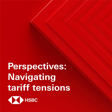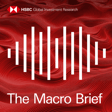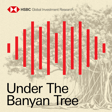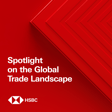Introduction and Overview
00:00:02
Speaker
Welcome to HSBC Global Viewpoint, the podcast series that brings together business leaders and industry experts to explore the latest global insights, trends, and opportunities.
00:00:13
Speaker
Make sure you're subscribed to stay up to date with new episodes. Thanks for listening, and now onto today's show.
Introduction of Guest and Conference Context
00:00:21
Speaker
Hello, everyone. This is Sean Henderson, Co-Head of Debt Capital Markets, AsiaPAC at HSBC. In this episode of Global Viewpoint, we are very lucky to have with us Laura Akers, Head of AsiaPAC Corporates at Moody's in the studio.
00:00:34
Speaker
It's great to have you with us here. Hi, Sean. Glad to be here.
Global Credit Landscape and Asia's Developments
00:00:38
Speaker
This episode is being recorded at HSBC's Asian Credit Conference 2025. And today we're going to talk about the global credit landscape with a focus on finding value as well as the need to know developments in Asia.
00:00:50
Speaker
So let's get started. Laura, I think it's important to put things into context to to begin the conversation.
Asia Pacific Company Ratings and China Impact
00:00:56
Speaker
Where do you think we are in the credit cycle? And what are the macro trends that you're seeing from a rating agency perspective?
00:01:04
Speaker
Sean, thanks for inviting me here today. um Let me start by setting the scene. and We publicly rate more than 400 companies in the corporate finance group in Asia Pacific. And our portfolio is spread across 17 markets and more than 17 sectors.
00:01:19
Speaker
Approximately 80% of these companies are investment grade. And what's interesting is how this has shifted over time. Five years back, we rated around 500 companies around the region, of which only 65% were investment grade.
00:01:33
Speaker
In absolute terms, the number of investment grade companies has remained around about the same, about 330.
Portfolio Quality and Regional Variations
00:01:40
Speaker
But the high yield portfolio has shrunk by over 60% to around 75 companies.
00:01:46
Speaker
And that's mainly due to the the turmoil that we have seen within the China property sector. which triggered, as you well know, a raft of restructurings, downgrades and rating withdrawals.
00:01:56
Speaker
The flip side to this is one could argue that today the overall quality of the portfolio in Asia-Pacific is arguably far stronger than it has been before. Now, looking forward, from an outlook perspective, some 23% of the entire portfolio is on negative outlook.
00:02:11
Speaker
Although for investment grade, this is only about 20%, whereas it's about 50% for the high yield sector. There is, however, a lot of variation around the region, with 40% of Greater China issuers having a negative bias compared to only 8% in India and 11% in Indonesia.
Sector Outlook and China's Sovereign Rating Influence
00:02:28
Speaker
Half of the negative base but companies that we see are in the chemicals, construction, oil and gas, property and retail sectors. In addition, the negative outlook that we have on China's A1 sovereign rating has a knock-on impact on some of our rated SOEs and LGFEs within that country.
Default Rate Forecast and Emerging Markets,
00:02:46
Speaker
It's also worth a minute or two just to look at defaults. In February, we forecast the trailing 12-month high-yield default rate for APAC to be about 4.1% the end of 2025, flat to the end of 2024, well the 10-year average default rate of 5.7%.
00:02:59
Speaker
and well below the ten year average default rate of five point seven However, the world is changing amid to tariffs and escalating geopolitical risk that has clearly impacted market volatility.
00:03:11
Speaker
So we may see some slight variations in the forecast default rate for the year, but we don't expect it to increase materially. What is really interesting, though, is that if you look at global emerging market corporates, of which APAC emerging markets clearly play a large part,
00:03:27
Speaker
We anticipate a lower default rate for emerging markets than we do for advanced economy. This is the first time this has happened in nearly five years and in part is reflective of the changing dynamics within the portfolio I mentioned earlier.
00:03:42
Speaker
Wow, that's really interesting, Laura. i You know, I didn't realize the default rates were quite so low in Asia, and it's really encouraging.
US Debt Downgrade and Fiscal Implications
00:03:49
Speaker
and Just looking more generally at and the sovereign space, ah you've recently downgraded the ratings for U.S. debt.
00:03:58
Speaker
um And the growing deficit is obviously a hot topic for many investors. Can you tell us a little bit more about the reasoning behind the downgrade? And does this kind of represent a fundamental shift in the US standing in the global debt markets?
00:04:12
Speaker
Okay, it's ah it's a great question and one that we're asked an awful lot. But maybe I can just summarise some of the the rationale that was behind the downgrade. So the downgrade to AA1 reflects long-term deterioration in US financial fiscal metrics.
00:04:27
Speaker
Pressure on the US's fiscal metrics have been building for years, well before our negative outlook in November 2023. Debt and interest burdens are now well above peers and successive administrations have failed to reverse large deficits.
00:04:42
Speaker
Current fiscal proposals are unlikely to deliver meaningful sustained deficit reduction. And over the next decade, rising spending and flat revenues will drive persistently large deficits, pushing debt and interest costs even higher.
00:04:55
Speaker
Now, all of that said, the AA1 rating with a stable outlook reflects the US's enduring strengths, its large, resilient economy. the dollar's reserve currency role, and a strong institutional framework, including an independent Fed.
00:05:12
Speaker
While policy uncertainty has increased, we expect these institutional anchors to remain robust.
Tariffs, Geopolitics, and Fiscal Challenges in Asia
00:05:18
Speaker
So comparing and contrasting the US again versus Asia, how are tariffs and geopolitics likely to impact the financial position for sovereigns within the region?
00:05:29
Speaker
Okay, so so looking beyond the US, tariffs and geopolitics are already shaping the fiscal landscape for sovereigns across Asia. We are seeing governments ramp up spending to cushion the impact of slowing growth, especially in response to tariff shocks.
00:05:46
Speaker
That's making post-pandemic fiscal consolidation more challenging. Countries such as Indonesia, Thailand and China have already rolled out additional support. In China, for instance, stimulus measures have widened the fiscal deficit significantly in early 2025 compared to last year.
00:06:03
Speaker
compared to lostette Korea may follow suit, with President Lee pledging 30 trillion won supplementary budget. But this increased spending comes at a cost.
00:06:14
Speaker
For economies still carrying elevated debt from the pandemic, the room to manoeuvre is limited. particularly for those reliant on external funding. And for trade or commodity-dependent countries, weakening revenues will further constrain fiscal space, even as borrowing needs rise.
00:06:32
Speaker
So while policy support is likely to continue, it will come with trade-offs, especially for sovereigns trying to balance growth with fiscal disciplines.
Impact on Asian Corporates and Default Rate Forecast
00:06:41
Speaker
Okay, so shifting the focus a little deeper within the economy, you recently published some research that talks about how you could see an increased default rate in emerging market corporates.
00:06:52
Speaker
Can you explain the likely impact of these tariffs on the corporate balance sheets? And are there any areas of particular concern in your view? Okay, so before I answer the question, let me just take a step back so I can explain how we actually considered ah the impact of tariffs on our portfolios.
00:07:10
Speaker
We conducted a global scrub of all corporates, and we essentially looked at the direct impact of tariffs, i.e. those companies who rely on exports to the United States as a means of revenue.
00:07:23
Speaker
We also looked at the secondary order impacts. So macro, essentially a slowing economy. And thirdly, financial disruption, essentially the impact of higher bond spreads, reducing investor appetite for lower rated company.
00:07:37
Speaker
Effectively, what that means for a company's ability to raise funds and critically to address refinancing needs. So having conducted this scrub um across the region's corporates, we actually found that most APAC corporates have either limited exposure from the issue of tariffs or have sufficient mitigants in place.
00:07:57
Speaker
In fact, only 6% of our portfolio had an overall high exposure. What is important to note, though, is that overall the impact of tariffs is relatively benign for the region's corporates.
00:08:09
Speaker
In some respects, it's not surprising because many of our rated companies comprise multinational companies with globally diversified operations, or they are supported by deeply entrenched domestic market positions, supported by strong consumer demand.
00:08:26
Speaker
And also what we find is that the many corporates have robust financial profiles which provide buffers in terms of stress. For instance, whereas the three risk transmission channels present risks, Indian companies, for example,
00:08:41
Speaker
with a predominant domestic focus, benefit from the country's favourable demographics, favourable government policies, and a funding environment that remains supportive. Similarly, in many instances, financial risk has been counted by the optionality afforded by relatively robust and deep domestic bank and bond markets, which have provided refinancing options for many of the region's corporates, even lowly rated ones.
00:09:08
Speaker
To go back to the final part of your question, which is how tariffs could increase default risks, we forecast a default rate among emerging market corporates of approximately 2.1% the end of Q1 2026.
00:09:20
Speaker
by the end of q one twenty twenty six It is likely that given the trade turmoil, default rates could end up at the higher end of our forecast, and the downside scenario takes that up to
Private and Public Credit Dynamics and Market Recovery
00:09:31
Speaker
But the fact is we remain past the peak in terms of the default cycle. More importantly, and I mentioned this before, but it's worth reiterating, we forecast that the default rate for advanced economies will be higher than that for emerging economies across the globe this year.
00:09:47
Speaker
and Well, that's really encouraging for Asia. and And I think in light of all the volatility around tariffs, you know, very pleasing to hear that that the market is adjusting so well. One of the hot buzz topics over the last year or so has been the rise of private credit.
00:10:02
Speaker
So I'm curious, you know, how do you see the rise of private credit affecting the public debt markets? And is the the relationship between these two markets competitive or do you see it as complementary? Okay. um High level, I would say that private credit, particularly in the region, is more complementary than competitive to public debt markets.
00:10:20
Speaker
In the main, we have seen that private credit provides funding to companies that are generally not sophisticated or large enough to be served by the public markets. They tend to replace bank credit rather than bond issuance and can serve as an additional source of funding. Private credit offers an alternative funding source to companies, especially those in niche sectors like data centres, real estate or infrastructure lending.
00:10:42
Speaker
Others include small and medium enterprises or distressed assets. In the distressed asset cases, banks sometimes have limited appetite to extend loans. So private credit could be attractive to firms that don't have good credit ratings or are indeed unrated.
00:10:59
Speaker
This segmentation can complement public debt markets by providing capital where it might otherwise be scarce. In markets such as India, we have seen many corporates look to private credit for funding.
00:11:10
Speaker
Unrated companies in many instances have those with strained financial profiles, or those that were challenged in raising cross-border financing. But there is a cost to this. So looking at the high yield market in particular, which is obviously very closely correlated to private credit, we've seen a good recovery in high yield volumes from the region, particularly out of ah jurisdictions such as Hong Kong and China and number of new issuers coming out of India.
00:11:37
Speaker
you know How does the high yield market today compare to pre-COVID times? And what are the trends that you're seeing from a rating agency perspective? OK, well, there's certainly been a rough few years in the high yield markets around the region.
00:11:52
Speaker
um But finally, we are starting to see some signs of recovery. The worst of the China property fallout seems behind us. and And while we're certainly not back to pre-COVID sentiment and probably won't ever be back there, there has been some positive momentum.
00:12:07
Speaker
Well, what's changed? For one, the market is no longer just about China property. If you think over the past 15 years or so, over 60% of issuance came from the China property space within the high-yield world.
00:12:20
Speaker
But what we're now seeing is more diversity by country and sector. India and Indonesia are stepping up, and even Japan and Australia are gaining traction. In fact, following a raft of fallen angels from Japan and Korea,
00:12:34
Speaker
we are on the cusp of actually seeing a fundamental shift in the high-yield markets across the region. Defaults have also come down sharply since 2022. We find that companies are managing debt maturity profiles better, refinancing locally where it's cheaper, and that's helping credit quality.
00:12:50
Speaker
And many issuers are domestically focused, so they're less exposed to global trade tensions. So while US dollar bond issuance is muted, yeah and pricing gaps certainly are a factor, local bank markets are filling the gap.
00:13:04
Speaker
But when issuers do go cross-border, demand has been strong, which suggests that there really is an appetite for high-yield issuance across the region. Having said all that, the same old challenges remain.
00:13:15
Speaker
Liquidity stress lingers for a few names, and rate volatility is keeping cross-border issuance in check. And let's be honest, yeah nothing has yet filled the void left by China property, and it could be a long time before we get issuance of that magnitude from a single sector.
Investment Grade Dominance and Future Growth in India
00:13:32
Speaker
So full recovery is a long way off, but it is coming, albeit slowly. And I guess given all the context and the background and the volatility and headlines, it's a pretty encouraging picture what you're painting there. And, and you know, pleased to hear the demographics and and the technicals of the market, I think, are ah you know really helping support the underlying markets.
00:13:54
Speaker
Just to wrap things up, are there any other key events or trends that you'd really recommend we keep a close eye on for the rest of 2025 and into Okay, well, I didn't bring a crystal ball with me, but ah in terms of the dynamics of the portfolio, it's worth reiterating that the APAC portfolio is dominated by investment-grade companies, in fact, 80% of our coverage.
00:14:18
Speaker
The bulk of that portfolio is also on a stable outlook. 2025 will see revenues and EBITDA grow modestly for the rated portfolio. And while debt levels will inch up slightly, leverage should remain flat to 2024 levels.
00:14:32
Speaker
If we look at tariffs, obviously we're keeping a very close eye on that. um And some would say that sort of change within the tariff environment is pretty much the only constant that we are seeing. We've also got rising geopolitical risks, which continue to present risks.
00:14:47
Speaker
But we see that we are past the peak default cycle and that the impact of tariffs is relatively benign for APAC corporates. So while there is some negative bias overall, we have a cautiously optimistic view of the portfolio.
00:15:01
Speaker
Other areas to look at, high yield issuance is one. We've seen a couple of high yield deals come to market this year, including a couple of China property companies, the first such issuance for over three years.
00:15:13
Speaker
um And also we've seen Medco as well as Vedanta come to market too. So there is definitely some appetite even for high yield issuers. So one of the other hidden gems that I think we need to think about is India.
00:15:24
Speaker
ah There are two sectors in particular that I think will get a lot of interest from the market, electronics and pharmaceuticals, as they are both clearly benefiting from the increased trend of supply chain diversification.
00:15:38
Speaker
A lot has been said about electronics manufacturing in India for the globe, but pharmaceuticals is another sector that would benefit, especially with India's large generics manufacturing prowess, and it's already established ties with generic exports to the United States.
00:15:54
Speaker
So to finish on a high note, I think you can see that there are actually a number of areas that we can look out for the positive around the region. yeah know Even though I'm a credit analyst, i ah I do like to remain ever the optimist, cautiously optimistic in this case.
00:16:07
Speaker
Laura, thank you so much for joining me on this episode of Global Viewpoint. It's been an absolute pleasure to talk to you today. And ah for our audience at home, thank you for taking the time to listen to our conversation.
00:16:18
Speaker
Sean, thank you for having asked me here today. It's been great. Thank you for joining us at HSBC Global Viewpoint. We hope you enjoyed the discussion. Make sure you're subscribed to stay up to date with new episodes.

















